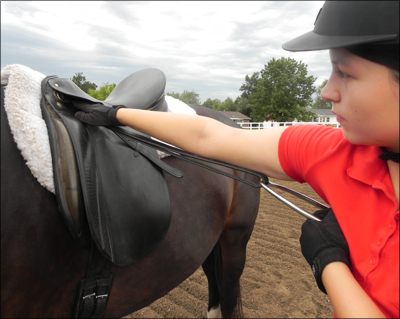
Riders:
Before you get on There's so much more to riding than
just sitting atop a horse. Your pre-ride
preparation and care of the horse can make all the
difference to your ride, and it demonstrates your
compassion for your horsey partner. Keep in mind that our horses spend
the great majority of their day standing in a
stall. Most of them are definitely NOT
spring chickens -- some are even older than you
are! It's just downright rude to walk in the
horse's stall, slap a saddle on his back, crank
the girth tight, and climb on. Spending some time
before mounting to relax the horse will prevent
"girthy-ness" or "cold backs" (gentler terms for
"the horse takes off bucking as soon as you put
your foot in the stirrup!"). We want our dressage horses' backs
to be relaxed and supple, and because of that,
there are some procedures that you'll follow
before you even climb up the mounting block. (And
yes, we always use a mounting block!)
A properly fitting saddle sits on
the horse's back with the cantle slightly higher
than the pommel. If the pommel sits higher than
the cantle, the rider will be forced into a "chair
seat." This is bad. For daily work, we use the big fluffy saddle pads (they're actually barrel racing pads) to protect the horse's back as much as possible. Keep the pads free of hay, sawdust, dirt and other things that might irritate the horse's back. The pads are shaped for wither relief, but make sure the pad is centered in the middle of the horse. There's a manufacturer's tag near the withers of most of the pads -- that faces up, not against the horse's skin. It's very
important to tighten your girth very slowly
in preparation for mounting. You do not want your
girth "mounting tight" when you lead your horse
out of the barn. When you're ready to saddle your
horse, fasten the girth just tight enough that he
can't put a foot through it. Then, maybe, put on
his protective equipment. Then tighten the girth a
notch. Then, maybe, apply fly spray, if it's that
time of year. Then tighten the girth another hole.
Then bridle him. Then tighten the girth a hole. Get the idea? Slow, gradual girth
tightening. When your horse leaves the barn, his
girth should only be tight enough to keep the
saddle on his back should he shake or jump. Once
you get to the arena, you'll continue to tighten
the girth while leading him a lap or two around
the ring. This gives the saddle a chance to settle
on his back. You never need to get the girth so
tight that the elastic has lost all its stretch.
The following video
demonstrates the proper way to lead a WWU horse.
This will take some experimentation
on your part, to know exactly how long your
stirrups should be, but the idea is to have the
stirrups at a safe length when you first mount. If
you need to make slight adjustments once you're
mounted, you can do that. The standard procedure is to put
your hand on the stirrup bar, and pull the stirrup
up into your armpit. The stirrup leather just be
just taut. If the stirrup doesn't reach your
armpit, lengthen the leather. If it reaches with
slack in the leather, shorten it. Spending time walking the horse
before mounting, and tightening the girth slowly,
will help the horse withstand the pressures of
mounting. But some horses will walk off. As long
as it's a quiet walk step, and not a gallop, we
tolerate this. If a horse needs to move to adjust
to the weight of the rider mounting, it's much
better for him to go forward than backward (or
up!).

Never let go of your horse! You may be working with the most
trustworthy horse ever, but you don't know when
something might frighten him. Even the most
bomb-proof horses will startle sometimes. When leading your horse, keep two
hands on the reins whenever possible. When working
with your horse's girth, saddle or stirrups, keep
one arm looped through the reins. You'll still
have use of both hands, but you'll remain attached
to the horse. Remember, our wonderful WWU school horses don't deserve careless handling! Thanks to Ciera Cordero, Amanda Cunningham, Jacki Moore and Ashley Sundin for being my models for this project. And thanks to Ellie, Tigger, Paul and Ripley! |
|
Karen's schedule and
office hours
|
| Copyright 1996-2014, Karen Pautz. All rights reserved. |
 There's
a chart in the tackroom that lists each horse and
the saddles that are known to fit him. There may
be other saddles that work, too, but start with
the ones on the chart.
There's
a chart in the tackroom that lists each horse and
the saddles that are known to fit him. There may
be other saddles that work, too, but start with
the ones on the chart. One of the things you can be doing,
while you're leading your horse around and slowly
tightening the girth, is to adjust your stirrups
to approximately the correct length.
One of the things you can be doing,
while you're leading your horse around and slowly
tightening the girth, is to adjust your stirrups
to approximately the correct length.